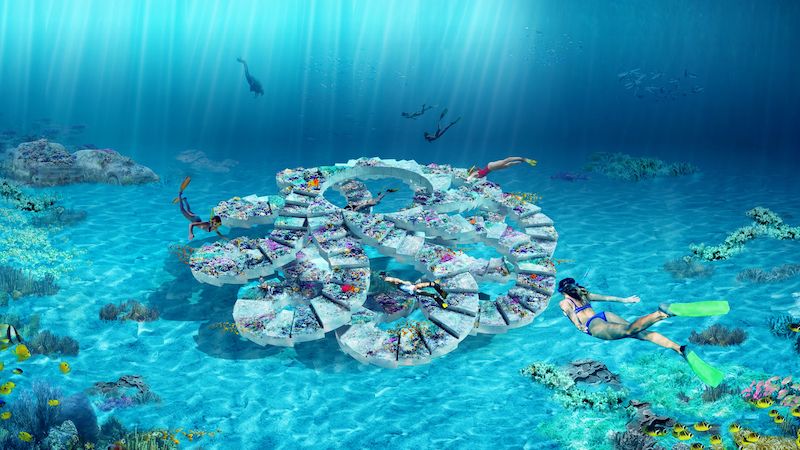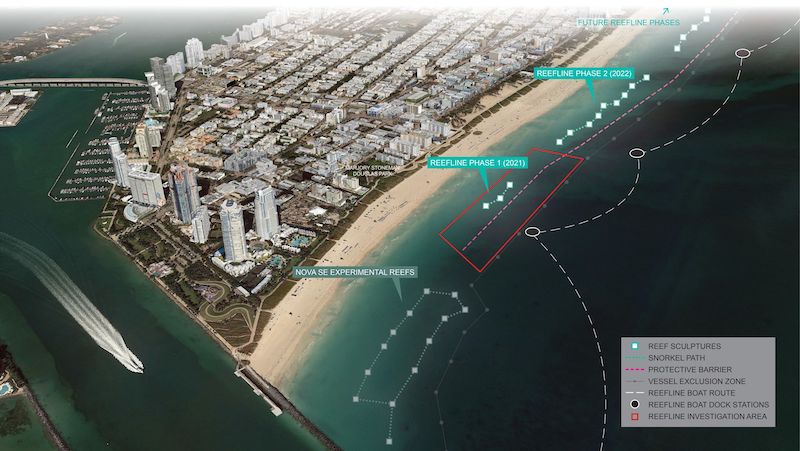The ReefLine will be a new seven-mile-long underwater public sculpture park, snorkel trail, and artificial reef located off Miami Beach’s shoreline. OMA is collaborating with a team of marine biologists, researchers, architects, and costal engineers to design the project’s master plan and a distinct sculpture within it.
OMA has designed a geometric, concrete modular unit that can be deployed and stacked from South Beach to the north, following the topography of the sea bed. The living breakwater is the connective tissue for the overall master plan and will be punctuated by a series of site-specific installations.

The project will be completed in phases. The first mile is slated to open in December 2021 with permanent installations by Argentine conceptual artist Leandro Erlich and Shohei Shigematsu of OMA. Erlich will create Concrete Coral, an installation that will reframe cars and trucks as new vehicles for environmental change.

OMA/Shigematsu’s sculpture explores the nature of weightlessness underwater. A series of sinuous spiral stairs creates a three-dimensional structure reminiscent of marine life. The organic form provides layered zones for coral reef growth and interstitial spaces for exploration. The stairs rotate around a central forum for underwater gathering and activities.
In addition to the artistic qualities, The ReefLine will also provide a critical habitat for endangered reef organisms, promoting biodiversity and enhancing coastal resilience.


Related Stories
| May 11, 2012
VFA to acquire Altus Group's Capital Planning division
Strategic move strengthens VFA's facilities capital planning market osition in North America.
| May 11, 2012
Betz promoted to senior vice president for McCarthy’s San Diego Office
He will oversee client relations, estimating, office operations and personnel as well as integration of the company’s scheduling, safety and contracts departments.
| May 11, 2012
CRSI appoints Brace chairman
Stevens also elected to board of directors and vice-chair.
| May 11, 2012
Dempster named to AIA College of Fellows
Altoon Partners’ technical and construction services leader honored for his contributions.
| May 11, 2012
AIA launches education and training portal
New portal to host Contract Documents training, education resources in one convenient place.
| May 10, 2012
Chapter 7 When Modern Becomes Historic: Preserving the Modernist Building Envelope
This AIA CES Discovery course explores the special reconstruction questions posed by Modern-era buildings.
| May 10, 2012
Chapter 6 Energy Codes + Reconstructed Buildings: 2012 and Beyond
Our experts analyze the next generation of energy and green building codes and how they impact reconstruction.
| May 10, 2012
Chapter 5 LEED-EB and Green Globes CIEB: Rating Sustainable Reconstruction
Certification for existing buildings under these two rating programs has overtaken that for new construction.
| May 10, 2012
Chapter 4 Business Case for High-Performance Reconstructed Buildings
Five reconstruction projects in one city make a bottom-line case for reconstruction across the country.
| May 10, 2012
Chapter 3 How Building Technologies Contribute to Reconstruction Advances
Building Teams are employing a wide variety of components and systems in their reconstruction projects.

















